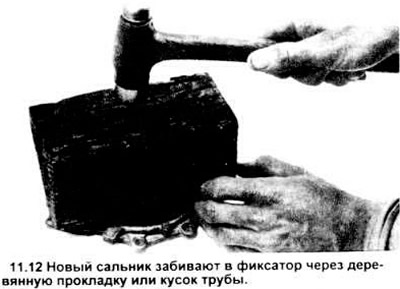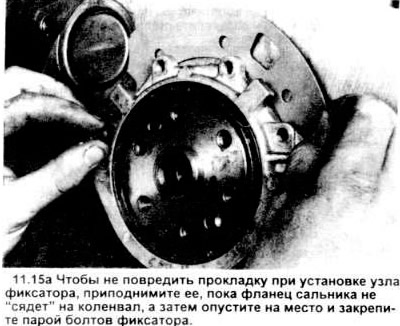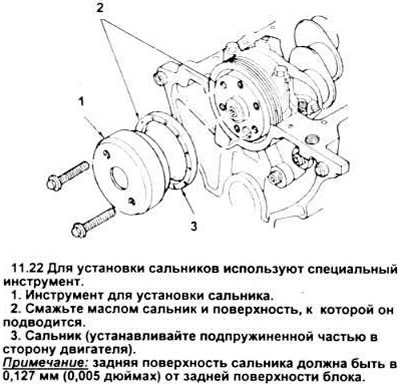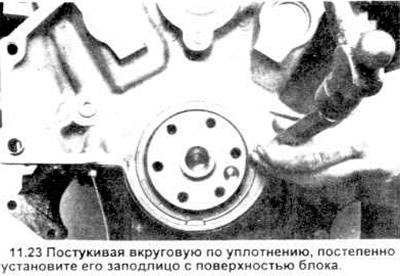Front oil seal of a four-cylinder engine
Note: This procedure is carried out on a removed engine. Replacing the front oil seals on V6 engines, see chapter 2B.
1. After removing the engine from the car and fixing the crankshaft (see picture), using a wrench, unscrew the bolt securing the pulley (see picture).


2. Remove the pulley from the crankshaft using a puller (see picture).

3. Using a large screwdriver, carefully separate the oil seal from the cover (see drawing).

4. Clean the opening in the cap and coat the outer edge of the new seal with engine oil or multipurpose grease. Using a socket with an outer diameter slightly smaller than the outer diameter of the oil seal, carefully install the new oil seal in place using a hammer (see picture).

If there is no socket head, a short piece of large diameter pipe will go. After installation, check the gland to make sure that the spring has not popped out of its seat.
5. Apply "moth" grease on the oil seal contact surface of the pulley hub, then slide the pulley onto the crankshaft. The keyway in the pulley hub must align with the keyway at the end of the crankshaft.
6. Screw in the bolt and tighten it to the required torque.
Rear seal of a four-cylinder engine
7. This procedure requires removing the engine and disconnecting the transmission and flywheel/drive plate.
8. You can replace the oil seal without removing the oil pan and retainer. But we do not recommend this method, because the gland flange is very rigid and may break off during installation or otherwise be damaged during installation.

Replacing the oil seal without removing the oil pan and retainer
Pry off the old seal with a screwdriver (see picture). Apply "moth" grease on the crankshaft seat and flange of the new oil seal, and carefully install the new oil seal. The flange is fragile, so be careful when using a smooth object such as the tip of an extension (see figure 13.14), until the seal is in place. In order not to damage it, do not make sudden movements.
9. The method recommended below is preferred, but requires the removal of the oil pan (see chapter 2A) and seal retainer.
Replacing the oil seal with the removal of the oil pan and retainer
10. After disconnecting the oil pan, unscrew the bolts, separate the retainer and clean off the remnants of the old gasket.
11. Place the retainer assembly on a pair of wooden stands on a workbench and use a punch to knock out the old oil seal (see picture).

12. Drive the new oil seal into the retainer through the wood spacer (see drawing) or a piece of pipe slightly smaller in diameter than the outer diameter of the stuffing box.

13. Lubricate the seat on the crankshaft and the flange of the new oil seal with grease "moth".
14. Slowly and carefully slide the oil seal onto the crankshaft. Its flange is fragile and hard, so when pushing it into place, tap on it with some smooth object, for example, the end of an extension cord (see picture).

15. Put a new gasket in place between the retainer and the block (see picture), then install and tighten the retainer bolts to the correct torque (oil pan guide) (see picture).


16. The remaining actions are performed in the reverse order of disassembly.
Rear oil seal of the crankshaft of six-cylinder engines
17. Remove drive plate (and rear cap, if any) (section 12).
Caution: Do not damage or scratch the surfaces of the oil seal, otherwise it may destroy the crankshaft or block.
18. Using a sharp awl, punch holes in the stuffing box between the flange and the engine block (see picture).

19. Screw in the threaded end of tool T77L - 9533 - B or equivalent.
20. If there is no special tool, remove the oil seal with a screwdriver (see picture).

21. Thoroughly clean the inner surface of the oil seal and the surface of the crankshaft in contact with it, lubricate the new oil seal with engine oil.
22. Place a new oil seal on the Ford T82L installation tool - 6701 - A (see picture) or similar. Place tool and oil seal on crankshaft. Tighten the bolts alternately to evenly install the oil seal (use drive plate bolts if necessary).

23. If it is not possible to use a special tool. carefully slide the seal flange onto the end of the crankshaft, and then drive into the hole with a hammer and a blunt chisel until it is fully installed (see picture).

Note: The back face of this gland should be 0.127mm apart (0.005 inch) from the back of the block.
24. Reinstall the drive plate (section 12).
25. Install the engine (section 4).
Visitor comments